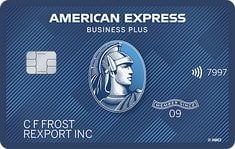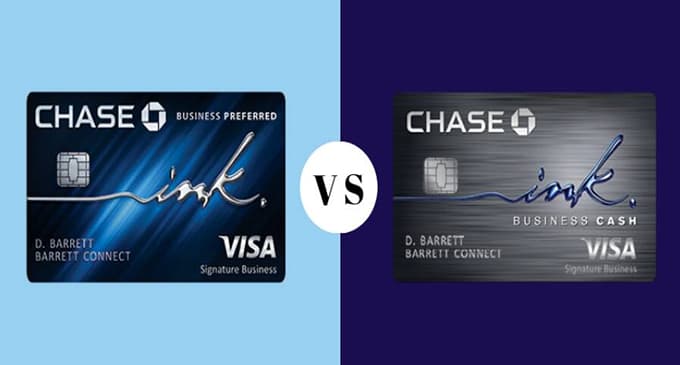The Blue Business® Plus Credit Card from American Express review
This card offers a fantastic rewards earning rate, particularly for a card that also allows you to earn rewards on purchases made over your credit limit. (See Rates and Fees)
Jump to Section
The Blue Business® Plus Credit Card from American Express
- Rewards
- Earn 2X Membership Rewards® points on everyday business purchases such as office supplies or client dinners. 2X applies to the first $50,000 in purchases per year, 1 point per dollar thereafter.
- Welcome Bonus
- Earn 15,000 Membership Rewards® points after you spend $3,000 in eligible purchases on the Card within your first 3 months of Card Membership.
- Annual Fee
- No annual fee
Key Features
- Earn 15,000 Membership Rewards® points after you spend $3,000 in eligible purchases on the Card within your first 3 months of Card Membership.
- 0.0% intro APR on purchases for 12 months from the date of account opening, then a variable rate, 18.49% - 26.49%, based on your creditworthiness and other factors at account opening. APR will not exceed 29.99%
- Earn 2X Membership Rewards® points on everyday business purchases such as office supplies or client dinners. 2X applies to the first $50,000 in purchases per year, 1 point per dollar thereafter.
- You've got the power to use your Card beyond its credit limit* with Expanded Buying Power.
- *The amount you can spend above your credit limit is not unlimited. It adjusts with your use of the Card, your payment history, credit record, financial resources known to us, and other factors.
- No Annual Fee
- Terms Apply
Editor Analysis:
- Earn two-times the points on your first $50,000 in purchases annually.
- Take advantage of an introductory 0% APR on purchases for 12 months from account opening (RegAPR after that). (See Rates and Fees)
- You'll earn points on purchases made above your credit limit, giving you earning power and flexibility (buying above your limit isn't unlimited; it's based on your payment history and other factors).
- If you routinely spend disproportionately in particular categories, you might be better served with a card that rewards purchases in those categories with a higher rewards-earning rate.
card_name benefits
When CardName marketing materials say the card will “fuel your vision,” they’re not kidding around. With two-times the points on your purchases up to $50,000 spent per calendar year, small business owners could see a huge return on their spending power. And there’s no annual fee to offset, meaning all rewards stay in your pocket. (See Rates and Fees. American Express is a CardRatings advertiser.)
Perhaps the one thing that sets Blue Business® Plus apart from its competitors the most, however, is the ability to spend above your credit limit (with certain terms and regulations, of course) and still earn rewards on those purchases. The flexibility that this affords small business owners is among the top reasons you should consider adding this card to your wallet if you’re a small business owner.
New cardholders can earn 15,000 Membership Rewards points once spending $3,000 in eligible purchases on the card within the first three months of card membership. There’s also intro 0% APR on purchases for 12 months from the date of account opening (then RegAPR), which can help small business owners buy the things they need without additional fees that sometimes accompany other banks’ terms. As far as ongoing rewards go, users can earn 2X Membership Rewards points on everyday business purchases such as office supplies or client dinners. The 2X applies to the first $50,000 in purchases per year, and then earn 1X per dollar thereafter. (See Rates and Fees.)
What we like best about card_name
Trust – it’s among the top things CardName is selling to its cardholders. With the flexibility to spend above your credit limit, American Express is choosing to trust its members.
The amount you’re allowed to spend above, while not set in stone and is subject to your credit rating, payment history, and other terms, not only allows you to purchase necessary items or services for your small to mid-size business, it also allows you to earn rewards on it. Talk about customer appreciation. And have we mentioned this card doesn’t charge an annual fee? (See Rates and Fees.)
The rewards you can earn based on your spending are also worth noting. There are no categories rotating month-to-month, so you have a bit less to think about when it comes to making the most of your business’ credit card rewards earning, but you also have the opportunity to earn more than the typical flat-rate rewards card.
Here’s the deal: On the first $50,000 spent each calendar year, you’ll earn two times the Membership Rewards points on all your purchases. After that first $50k you’ll earn one point per $1 spent.
For small business owners looking to make some big purchases and pay interest-free over time or just to rack up rewards for regular business purchases, this card could be an excellent tool in helping you achieve business success.
Potential downsides of card_name
Although the introductory 0% period is nice, don’t let it lull you to sleep so much that you allow your balance to grow unchecked. You’ll want to make a plan to pay off the balance before the intro period ends. Additionally, while the opportunity to earn two times the Membership Rewards points on the first $50,000 spent annually is nice, if you know you’ll spend well above that each year you could likely earn more rewards with a card that offers a higher spending cap for its highest rewards (that said, you’ll probably pay an annual fee for those cards).
Additionally, if you spend more in specific categories, you might not be rewarded with CardName as much as you would with another card that offers higher rewards in particular categories.
card_name approval odds
Do you qualify for CardName?
The list of people who can apply for a small business credit card is long, and includes freelancers/self-employed individuals, entrepreneurs, small business owners/officers, owners/officers of established businesses, and owners/officers of startups. Most credit card companies define “business” quite broadly when it comes to considering applicants for small business credit cards. To qualify for a business credit card, you must be an “authorized officer” of a company. Basically, this means that you must have the legal right to enter into borrowing arrangements with financial institutions on behalf of a business. If you are the owner of a sole proprietorship business or the sole owner of a small business, you are already an “authorized officer.” You are, after all, the only owner of the company. It can be more complicated determining who ranks for businesses that have multiple owners. In general, though, most owners are also “authorized officers.”
Credit card issuers consider each application on its own merits, so don’t assume you don’t qualify just because your business might not fit that standard business model. Do keep in mind though that your personal credit history will likely be what is used to determine your eligibility and/or credit limit on a business card before you’ve built up a credit history for your business.
If your business doesn’t have a tax ID number (EIN), you can enter your personal social security number instead. In general, try to have the following information handy when you apply:
- Business name
- Business name as you want it to appear on the card
- Business address
- Type of business
- Tax ID number (or your social security number)
- Number of employees
- Annual revenue/sales
- Monthly expenses
- Number of years in business
- Ownership type (publicly traded, privately owned, etc.)
- Business structure (LLC, corporation, non-profit, etc.)
To learn more about who can qualify for a small business credit card, and how to apply for one, be sure to check out our tips for getting your first business credit card.
How do cardholders rate card_name?
CardRatings conducts a survey annually to learn what actual cardholders think of their cards. Here are the results for CardName:
| Current Scores | Past Scores | |
|---|---|---|
| Overall Score | 79.9 | 76.5 |
| Rewards Program Satisfaction | 8.0 | 7.6 |
| Customer Service | 7.9 | 7.7 |
| Website/App Usability | 8.3 | 7.7 |
| Likelihood of Continuing to Use | 7.9 | 7.8 |
| Recommend to a Friend/Colleague | 8.0 | 7.5 |
How does card_name compare to other business cards?
card_name vs. CardName
discontinued
First things first. The annual fee for the CardName is AnnualFees. (See Rates and Fees)
That said, there’s a lot of benefits that come along with this.
The CardName offers a lot of rewards that should easily pay for the annual fee, provided your business spends a lot. You’ll earn 4X Membership Rewards points on the two categories where your business spends the most (each billing cycle) from six eligible categories. While your top two categories may change, you will earn 4X points on the first $150,000 in combined purchases from these categories each calendar year (then 1X thereafter). Only the top two categories each billing cycle will count towards the $150,000 cap. Additionally, earn 3X Membership Rewards points on flights and prepaid hotels booked on amextravel.com using your card. You also pick up 25% points back after you use points for all or part of an eligible flight booked with Amex Travel, up to 250,000 points back per calendar year.
As for the welcome offer, with the CardName, new cardholders can earn 70,000 bonus Membership Rewards points after spending $10,000 during the first three months.
card_name vs. card_name
discontinued
These two credit cards are for business professionals, but that’s really where the similarities end.
The CardName rewards new cardholders with 50,000 bonus miles once spending $4,500 in the first three months of account opening, and for ongoing rewards, cardholders can earn unlimited 2X miles per dollar on every purchase, everywhere, with no limits or category restrictions. Plus, earn 5X the miles on hotel and car rental bookings through Capital One Travel.
Is card_name a good card?
CardName is a great card for small business owners who want cash back as well as simplicity. With allowed spending above your credit limit, you have the flexibility you need to make decisions on the go for your business. The new entrepreneur or small business owner could find this card fits perfectly with their needs.
Frequently asked questions
What credit score do you need for card_name_placeholder?
What is the credit limit for card_name_placeholder??
Our methodology
Survey methodology: CardRatings commissioned Op4G in September and October 2022 to conduct surveys among 1,554 cardholders nationwide. CardRatings website analytics from Jan. 1, 2022-Aug. 31, 2022 were used to determine a selection of the most popular cards and additional cards were included to add survey breadth. Responses to each of nine questions were given on a scale of 1-10 and respondents’ scores were then averaged under broad topics. To determine the overall score, responses from questions 1-8 were summed and the answer to “How likely are you to recommend this card to a friend, coworker or family member?” was double weighted. “Current Scores” reflect scores from the most recent survey (2022); “Past Scores” reflect scores from the 2021 survey.
Disclaimer:The information in this article is believed to be accurate as of the date it was written. Please keep in mind that credit card offers change frequently. Therefore, we cannot guarantee the accuracy of the information in this article. Reasonable efforts are made to maintain accurate information. See the online credit card application for full terms and conditions on offers and rewards. Please verify all terms and conditions of any credit card prior to applying.
This content is not provided by any company mentioned in this article. Any opinions, analyses, reviews or recommendations expressed here are those of the author’s alone, and have not been reviewed, approved or otherwise endorsed by any such company. CardRatings.com does not review every company or every offer available on the market.
For rates and fees of American Express cards mentioned in this post, please see the following links: CardName (See Rates and Fees); CardName (See Rates and Fees); CardName (See Rates and Fees).












